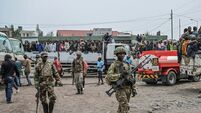Thousands flee as cyclone hits Australia
Tropical cyclone Larry smashed into the coastal community of Innisfail, about 100km south of Cairns, a popular jumping-off point for the Great Barrier Reef, forecaster Jonty Hall said.
The weather bureau upgraded the storm to a category five - the strongest category possible - and thousands of local residents were evacuated ahead of the cyclone’s arrival.














